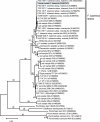Francisella tularensis subsp. novicida isolated from a human in Arizona
- PMID: 19895698
- PMCID: PMC2780447
- DOI: 10.1186/1756-0500-2-223
Francisella tularensis subsp. novicida isolated from a human in Arizona
Abstract
Background: Francisella tularensis is the etiologic agent of tularemia and is classified as a select agent by the Centers for Disease Control and Prevention. Currently four known subspecies of F. tularensis that differ in virulence and geographical distribution are recognized:tularensis (type A), holarctica (type B), mediasiatica, and novicida. Because of the Select Agent status and differences in virulence and geographical location, the molecular analysis of any clinical case of tularemia is of particular interest. We analyzed an unusual Francisella clinical isolate from a human infection in Arizona using multiple DNA-based approaches.
Findings: We report that the isolate is F. tularensis subsp. novicida, a subspecies that is rarely isolated.
Conclusion: The rarity of this novicida subspecies in clinical settings makes each case study important for our understanding of its role in disease and its genetic relationship with other F. tularensis subspecies.
Figures


References
-
- Johansson A, Farlow J, Larsson P, Dukerich M, Chambers E, Bystrom M, Fox J, Chu M, Forsman M, Sjostedt A, Keim P. Worldwide genetic relationships among Francisella tularensis isolates determined by multiple-locus variable-number tandem repeat analysis. J Bacteriol. 2004;186:5808–5818. doi: 10.1128/JB.186.17.5808-5818.2004. - DOI - PMC - PubMed
LinkOut - more resources
Full Text Sources
Molecular Biology Databases

